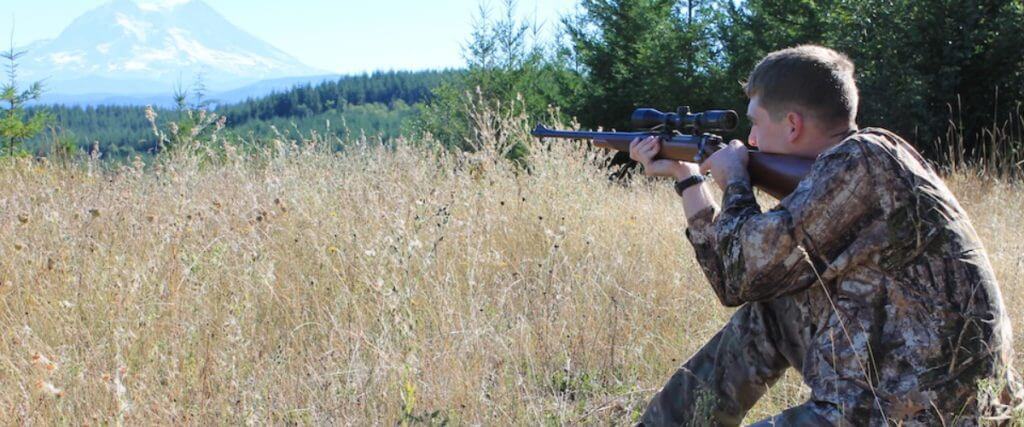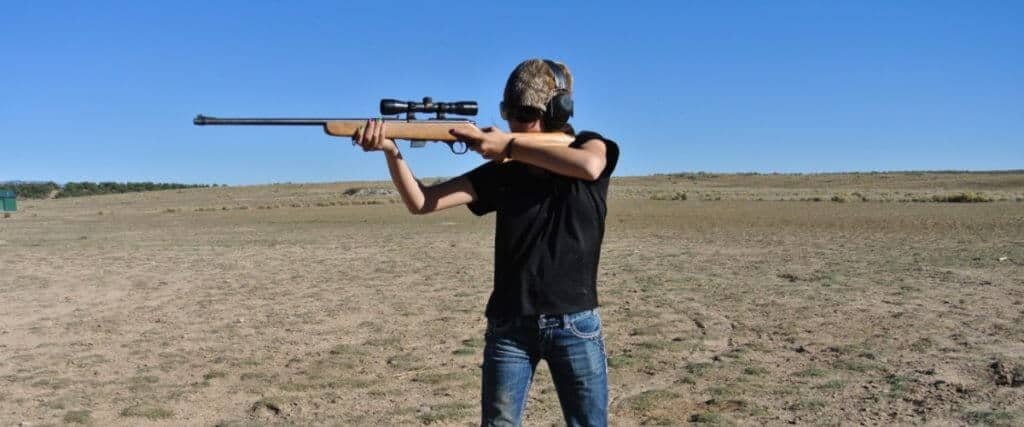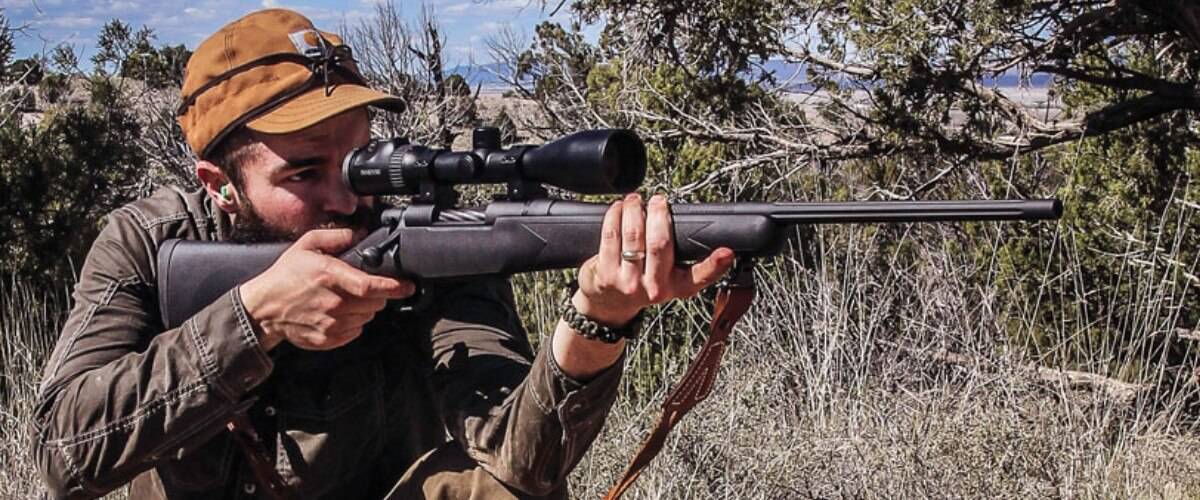A hunter will be faced with different challenges when out in the field. Thankfully, there are four main shooting positions that you can count on. The four standard rifle firing positions are standing, kneeling, sitting, and lying prone on the ground, in order of least stable to most stable.
These rifle firing positions are the most stable and reliable rifle positions to tackle different hunting encounters and will more likely give you the most important thing of all – the kill.
Why Position Matters

Position matters because stability matters. You will notice that those times that you make a successful kill will be those times that you were in a stable position.
Being in a stable position gives you the time and bandwidth to stay composed enough to have trigger control and the correct sight alignment. This will afford you the chance to observe your surroundings and plan your next move.
Also, being in one of the four rifle stances will not tire you out easily when waiting extended periods for the perfect opportunity to pull the trigger on your target.
Using the proper rifle shooting positions also has their practical reasons as to why all hunters have to master them. They are safe, and they get you your prize. Wouldn’t anyone want to get home safely with some meat after an epic hunting trip?
As a hunter, it is also your responsibility to harvest game only through ethical kill shots. Securing an ethical kill shot is challenging enough on its own, so make sure you secure your probabilities of making only ethical kills through mastering the four basic rifle shooting positions.
The Standing Shooting Position

The standing shooting rifle pose is the least stable of the four basic positions. Shooting a hunting rifle in the standing position is the quickest to assume, though.
The outdoors does not always present the most ideal hunting conditions. Tall grass, random terrain, and other challenging situations demand you to be in the standing shooting position to get that all-important kill.
There are 2 ways to properly execute the standing shooting position: standing without support and standing with support. Here is a more in-depth discussion to differentiate the two.
Without Support
Also called shooting offhand, shooting without any support requires a hunter in the standing position to bear the weight of his rifle solely on his arms while aiming a shot. This can prove to be challenging, but this is a position that every decent hunter must master, nonetheless.
Shooting offhand also gives a hunter the greatest view of the field as he or she stands tall over tall grass and bush. This view comes at a price, though, because standing is the least stable shooting position.
When does a hunter need to shoot offhand without any support? Targets that are less than 50 yards out should not be hard to take out when in the standing position.
Hunters shooting for small game or pests are comfortable standing without support when shooting with their 22 LR rifles. The best rimfire scope options remain reliable at this relatively unstable position due to the lightness of the rifles they are mounted to.
To execute the offhand shooting position, approximately place your feet shoulder-width apart. Hold the fore-end of the rifle with your support hand (that’s your left hand, if you are right-handed, the opposite if you are left-handed) and point your left elbow downward. Hold the grip with your dominant hand with that elbow pointing out sideways.
With Support
Shooting in a standing shooting position with support means that a hunter uses anything within his resources as their rifle support. This support may be shooting sticks, a tripod, a bipod, a monopod, a tree, or anything you can use as support in the wild.
The Kneeling Shooting Position
The kneeling position provides a decent amount of stability and is the second quickest position to assume. Kneeling offers concealment and terrain visibility for a hunter who is positioned behind tall grass or bush.
To execute the kneeling shooting position, get down on your dominant knee at a 90-degree angle to your support foot, which you plant flat on the ground. Sit on the instep of your dominant foot. Sitting on your instep will provide more comfort and stability compared to sitting on your heel.
Rest your supporting arm on your supporting knee. If you are right-handed, that would be your left arm resting on your left knee. Do not rest the point of your elbow on your knee by planting it down on your knee. Instead, use the flat of your triceps as this provides for more stability.
Competitive riflemen using the 6.5 Creedmoor scope on their long-range sport shooting rifles master the kneeling position as it is included in the three shooting stance rifle competition that also includes shooting prone and sitting.
The kneeling position also offers the use of additional support. Rest the rifle on crossed shooting sticks, a rock, or a hasty sling. If accessible, always take measures to help in making your position more stable to get an accurate shot.
The Sitting Shooting Position
The seated position shooting stance takes a bit more time to assume than the standing or kneeling position, but it comes with its advantages. Sitting gives you enough clearance over low to medium height obstacles like grass, rocks, or bush that would be challenging for being in the prone position.
The sitting shooting position has a few variations: the open leg, cross leg, and cross ankle variations. All these may feel more comfortable when done against a tree. Here is a quick discussion on how these variations should be executed:
Open Leg
Sit on your buttocks with your body angled to the right of your target. This facilitates a more comfortable stance, as holding the rifle will be supported by the width made by your arms and body. Place your feet about shoulder-width apart and spread your knees a bit wider. Keep your supporting foot planted flat on the ground as you possibly can and cradle your supporting arm’s triceps on the small ridge made by your knee cap and your inner knee. Place your dominant elbow below the knee and the inner thigh. Pull your dominant leg (left leg, if you are left-dominant) to make a better rest for your dominant elbow.
Cross Leg
Sit on your buttocks with your body angled to the right of your target. Cross your support leg over your dominant leg. Position both elbows behind their respective kneecaps but more to the inner thigh side.
Cross Ankle
Sit on your buttocks with your body angled to the right of your target. Cross your dominant leg over your support leg. That is right over left if you are right-handed. Position your elbows on your thighs as you would deem most comfortable. Cross ankle position is what children call ‘Indian sitting’.
The Prone Shooting Position
The prone shooting position takes the longest time to assume but is the most stable among all the four basic positions. This is best used if there are few natural obstacles to obscure the hunter’s vision.
Lie on your stomach with your body pointing slightly to the right of your target. Draw your dominant leg up as if to crawl. Your non-trigger hand should have its elbow on the ground. Make sure to have a good view through your sights or your long-range rifle scopes and try to keep your head as close to the ground as possible.
There are 2 ways to position yourself in a prone shooting position: supported and unsupported. Here is a quick description of both:
Supported
Supported prone means that the fore-end of your rifle rests on support like bipods, a bag, a rock, a branch, or anything you find in the field. Just remember to get a softer object like a rolled-up jacket between your rifle and the hard surface of a rock or a branch. Having a hard surface will adversely affect your accuracy.
Unsupported
To achieve a good unsupported prone stance, lie on your stomach. Spread your legs apart and lie your ankles on the ground flat while pointing your toes outwards. Rest the butt of your rifle snugly in the pocket your neck and your dominant shoulder makes. Keep your body flat on the ground as much as possible. Adjust for comfort and best sight view of your sights or rifle scopes.
Using Shooting Supports
Bipods, tripods, monopods, sandbags, and slings are easily available in various gun stores to provide the advantage of extra stability that only shooting supports can offer. The only disadvantage they bring is that they can be bulky and heavy to lug out in the wilderness. Make sure that you bring shooting supports that are worth it.
Be a Master Hunter
You will never know for sure what conditions the wilderness will throw at you when out on a hunting trip. Be ready to tackle any condition by mastering every shooting position a hunter should master, and you will have a more successful time hunting.
Mike Fellon is an experienced firearms enthusiast and optics expert. He delivers unbiased and detailed rifle scope reviews. Born and raised in Dallas, Texas. He inherited his hunting passions after his father John – he was fascinated by his stories, hearing how much attention, focus, dedication and patience he invested in shooting every animal. When he was old enough, his father first allowed him to shoot some cans and bottles with his shotgun, and then took him hunting – it was love at first sight. Mike has never stopped shooting ever since.

